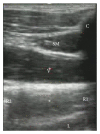The Relationship of the Subclavius Muscle with Relevance to Venous Cannulation below the Clavicle
- PMID: 26966432
- PMCID: PMC4761380
- DOI: 10.1155/2016/6249483
The Relationship of the Subclavius Muscle with Relevance to Venous Cannulation below the Clavicle
Abstract
Introduction. The catheter "pinch-off syndrome" has been described to be secondary to crimping of the catheter between the clavicle and the first rib, as well as entrapment of the catheter at the site of penetration of the subclavius muscle. The lateral insertion technique has been recommended to prevent catheter pinch-off, but it is unknown if this technique can prevent entrapment by the subclavius muscle. We undertook this study to evaluate the anatomical relationship of the subclavius muscle and the subclavian vein. Methods. Twenty-eight adult cadavers were studied on both right and left sides. The adherence between the subclavian vein and subclavius muscle was subjectively assessed and the distance between the two structures was measured in mm. Results. The subclavius muscle and subclavian vein were tightly adherent in 72% of specimens, partly adherent in 14% with a mean distance of 4.5 mm and loosely connected in 14% with a mean distance of 6.1 mm. Conclusions. The anatomical relationship between the subclavius muscle and vein was very close in the majority of specimens, suggesting that the lateral insertion technique may not prevent penetration of the muscle, which may contribute to catheter pinch-off. The real-time ultrasound-guided technique may prevent penetration of the subclavius muscle.
Figures



References
-
- Magney J. E., Flynn D. M., Parsons J. A., et al. Anatomical mechanisms explaining damage to pacemaker leads, defibrillator leads, and failure of central venous catheters adjacent to the sternoclavicular joint. Pacing and Clinical Electrophysiology. 1993;16(3, part 1):445–457. doi: 10.1111/j.1540-8159.1993.tb01607.x. - DOI - PubMed
LinkOut - more resources
Full Text Sources
Other Literature Sources

